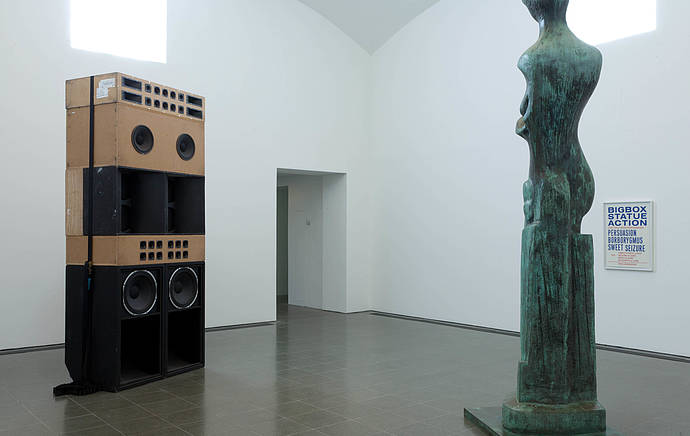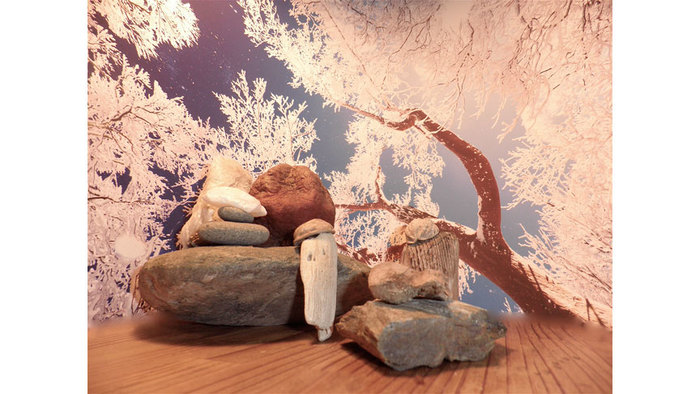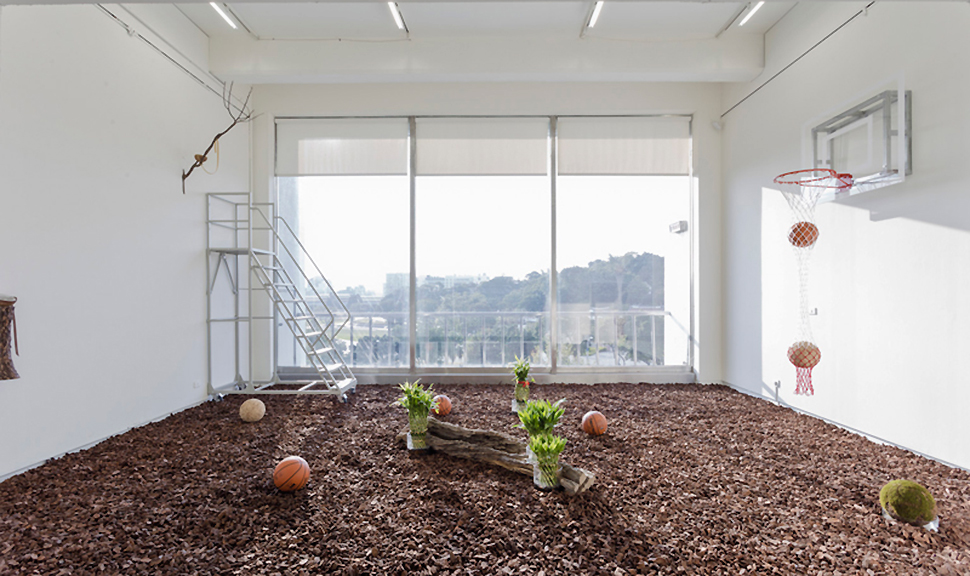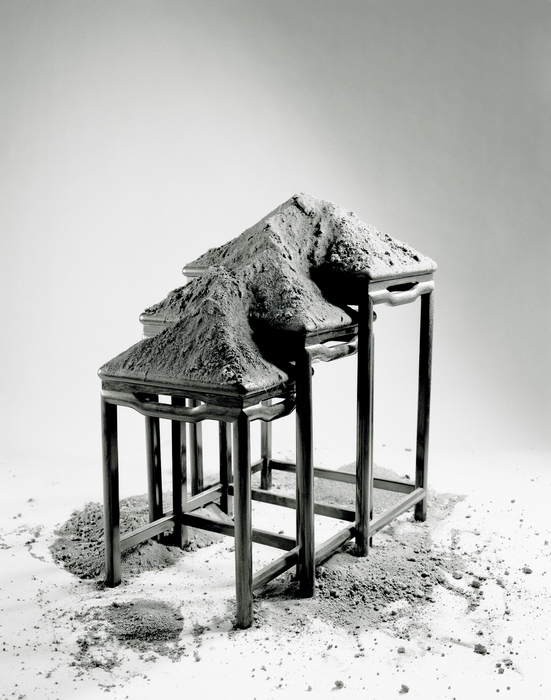
Mark Leckey, BigBoxStatueAction, 2003 – 2011
I’m increasingly convinced that too much contemporary art making is becoming cultic and pseudo-religious. I see this trend most clearly in the various attempts to dematerialize art objects, the increasing visibility of relational art and most recently with the popularization in visual art discourse of the currently unofficial stratigraphic term “Anthropocene.” I think much of this turn toward the mystical is a result of concerns about high concentrations of wealth and existential fear about the destruction of human civilization due to catastrophic global climate change. These factors and the fact that avant-garde art argues for a linear, progressive aesthetic evolution has led to a general acceptance of eschatological pseudo-philosophy in the visual arts.
The Turner Prize-winning artist Mark Leckey has suggested that people can approach works of art without the benefit of language by “empathizing with objects.” Former Menil curator and current Perez Art Museum director Franklin Sirmans said of the artist Glenn Kaino (who was included in Sirmans’ Prospect New Orleans 3 and currently on view at the Modern in Fort Worth): “There was something about the work—so based around science and technology but at the same time based around magic and spirituality. Glenn mixes them so easily.” The examples of this kind of thing really are endless and kind of astonishing.

Adam Avikainen, CSI Department of Natural Resources, 2014, from HKW’s Anthropocene Working Group.
The term Anthropocene was first coined in 2000 by scientists Eugene Stoermer and Paul Crutzen. Anthropocene is meant to describe a geological epoch in which humans have caused mass plant and animal extinctions, changed the atmosphere with CO2 emissions and polluted the earth’s oceans. Officially, the Earth is still in the Holocene Epoch. Anthropocene is a cultural and political term masquerading as (and campaigning for inclusion in) science. Many geologists are skeptical of adopting the term because there is no clear demarcation in the sediment layer to which they can point to as the start date. Recent analysis by scientists at the Smithsonian National Museum of Natural History point out that anthropogenic changes in plants and animals began about 6,000 years ago when agriculture first spread around North America. The term Anthropocene has not been adopted by The International Commission of Stratigraphy. It is set to make a determination on the matter later this year.

Jr-Shin Luo’s Terrarium: “Ong Lai,” “Bird’s Nests,” “Moss Balls,” 2014, Taipei Biennial.
Last year the high priest of Relational Aesthetics, Nicholas Bourriaud gave a lecture at the Fort Worth Modern on the possible cultural ramifications of this new pseudo-geological epoch. I recently listened to his lecture on the Modern’s podcast series and thought I’d share some thoughts here. In Bourriaud’s essay for The Great Acceleration, his 2014 iteration of the Taipei Biennial, he writes, “It is in this historical context that Speculative Realism has emerged—a holistic thought that humans and animals, plants and objects must be treated on an equal footing.” Speculative Realism (the name should already arouse suspicion) is also known as metaphysical realism (which should arouse even more suspicion) and asserts that the world around us is independent of our perception of it. This kind of realism is called speculative or metaphysical because it absolutely cannot be proven to be real. As in: God exists, he really does. You just can’t see him! This of course is anti-scientific and anti-Enlightenment. At the heart of all religion is a belief in an essential reality that cannot be falsified.
In his talk at the Modern Bourriaud makes the claim that art in the 21st century is not about looking at a work of art through your eyes and the mental processes of your brain but allowing the artwork to look at you. Bourriaud asserts (and promotes) the idea that the subject/object relationship is falling apart. He takes as a matter of fact that in the Anthropocene, the boundaries between human, animal, plant and manufactured object have dissolved. This allows him to assert that we have entered a new evolutionary phase in which ancient and superstitious ideas like animism, in which human or animal attributes are attributed to inert objects, has reasserted itself as a viable strategy not only for art making but for survival in the face of global climate catastrophe.

Arthur Ou, Untitled (Mountain), 2007
The idea is a kind of return to Eden where lions lay down with lambs. Bourriaud’s interpretation of art in the Anthropocene is one in which artists attempt to model a return to the wholeness of human existence or illustrate the tragedy of our disconnection with nature. These are essentially religious precepts that correspond to ideas about heaven and hell. At the heart of all this is a feeling of helplessness in the face of an economic system which seems to assert control over every aspect of human life and a paralyzing fear of environmental collapse. Humanity will continue to stumble along, facing disaster in its makeshift way just as it has for thousands of years. But it is possible that if we resist the appeals to salvation and damnation inherent in Bourriaud’s Anthropocene we may be able to do it on our feet instead of our knees. Artists might do well to empathize with their fellow human beings and stop talking to rocks.



19 comments
I’m not sure I understand your level of skepticism. Clearly this tendency towards new animism, object oriented ontology, and speculative realism is not restricted to the art world but is happening on a much wider scale in philosophy and other disciplines, despite how it’s represented here.
While I’m sure it’s true that the idea of the Anthropocene might not have been given official status in scientific research, it’s a helpful conceptual tool. Don’t we have to recognize that the logic of science and the logic of capital are linked in our society, and isn’t it useful to speculate that undermining that logic at its core might be the only way to escape its “eschatological” conclusions? As Zizek has said “Plato leads to NATO”. If the implications of philosophies that elevate the “human” above the “natural” are disastrous, maybe re-casting our assumptions this way makes sense. And why not do this work through art?
Maybe I’m wrong here, but it seems that Michael is skeptical of the religious implications of these ideas. As someone who was raised with a mystical and oppressive religion, this sort of thing terrifies me… especially if artists are starting to embrace it. I came to art in order to make my own ontology – purposefully separate from anything someone else is prescribing. If art is taking on this prescribed ontology it might very well become really boring, kind of like going to church. And that is something I ran away from with enthusiasm. If we can’t criticize art because it’s about spirituality which is a very personal and inscrutable thing, then by god we will criticize spirituality itself. But really, without getting too heady about it – what’s really going on here is that language is being invented that can too easily be used to justify boring, esoteric art… and there’s already too much of that in my opinion.
Art certainly doesn’t need spirituality to be boring. That’s kind of a universal if there ever was one…
I get the skepticism of religion, don’t get me wrong. I used to be part of a cult, so I totally understand. But is it “the spiritual” or the dogmatic and heirarchical organization of power that really scares us about “church”? That can occur anywhere, as we can see all around us all the time. Science can be just as much of a dogma, but in the service of “human reason”. What is being criticized in the article is an emerging sphere of thought that makes its mission to decenter the “human”, or to deconstruct hierarchy. That sounds pretty good to me.
Decenter the human? Ok, that sounds great. I would love to see art made from a non-human perspective.
Michael, thanks for the always polite tone of your comments.
That said, it’s incredible that you think science is dogma. Science makes no claims for anything that it cannot prove and is always ready to revise its assertions pursuant to new evidence. Similarly, it accepts that there are many things it cannot prove. There’s no question that the products of science are often used for destructive purposes. This does not mean that we should undermine the logic of science.
The logical endpoint of object-oriented ontology is irrationalism. David Hume famously said (basically) that no one can prove that a rock doesn’t have consciousness. We can’t prove that it does either. Some things are closed off from our understanding. Nothing has happened to disrupt Kant’s assertion that the world is understood through the limited capacities of the human mind. Whether you like it or not, we are still the center of our own universe. To propose otherwise is to go down a dark road.
https://en.wikipedia.org/wiki/The_Sleep_of_Reason_Produces_Monsters
As for decentering the human, the most radical decentering of the human in the history of the human was performed by an astronomer named Copernicus who figured out that the Earth wasn’t the center of the universe.
I’ve read plenty of Zizek. He’s fun, but he’s a buffoon.
M
This article from some days ago, coincidentally, is an interesting read for anyone here if not already fresh in their minds already having scanned it. Not to try and apply it as a counter or support for anything being said here, but follows the train of thought no less.
http://www.theguardian.com/books/2016/apr/01/generation-anthropocene-altered-planet-for-ever
http://www.theguardian.com/environment/2016/aug/29/declare-anthropocene-epoch-experts-urge-geological-congress-human-impact-earth
https://m.youtube.com/watch?v=7W33HRc1A6c
Hmmmm, that as a response makes me question what your beef with the Anthropocene really is.
One doesn’t have to believe in the concept of “saving the planet” to believe that we have collectively thrown it out of the balance that allows us to be here. Not that it necessarily matters in a cosmic sense.
https://www.youtube.com/watch?v=9oX2xFo7JA4
very disappointed in the level of writing here ~ embarrassing.
please work harder if you expect our time and attention.
i expect better from GlassTire.
…coming from a guy who can’t be bothered with capitalizing or grammar…
Religion? Talking with fellow human beings? The subject/object relationship falling apart?
I reckon that’s well-covered here, citizen: http://www.brnnr.net/#/pikamas-1/
(Although, of course, James Case~Leal may well expect better.)
Morris and Case-Leal nail it. The concept of anthropocene has some useful applications. The literature is full of them. If the author is going to jump into the river, he ought to learn how to swim.
“well i woke up this mornin’ and i got myself a beer
the futures uncertain and the end is always near”
“cancel my subscription to the resurrection,
send my credentials to the house of detention… i got some friends inside”
“the monk bought lunch”
-jm
James Case-Leal,
What the hell kind of precedent has Glasstire established that makes you expect better of it???!!!
Michael Bise,
I always appreciate your insight and will read anything you write. Thanks for making Glasstire suck less. Thanks, also, for having the guts to write with an editorial perspective and not being compelled to kiss the asses of the Dallas Bourgeoisie.
Philosophically poignant, relevant, or otherwise, I’m sick of the Pottery Barn aesthetic that the Dallas area champions.
I want to echo Michael Morris’ comments, particularly with regards to philosophy and art. Art is one of those aspects of culture (as opposed to consumerism) which can allow and encourage us to stop behaving in such a hubristic way toward the environment in which we inhabit. An environment we have mistakenly (and possibly tragically) believed we can shape toward our short-sighted desires without understanding–or attempting to understand– our role as agents of change in a complex web of what anthropologist Gregory Bateson called, ‘circuits of contingency’. He also considered beauty (which one could count among the many goals of the project of art) to be that experience which reminds us of our place in these circuits–the individual, the social, and the ecological.
Mysticism, animism, new ontologies–these are all necessary and natural responses to the enforced neoliberal condition in which we find ourselves where nothing has any intrinsic value unless that value is a market value. Neoliberalism, by necessity, occludes any kind of spiritual behavior that might sustain us and our world, because it is predicated on unrestrained growth and consumption. Which could also describe cancer.
http://davidmaisel.com/portfolio-item/terminal-mirage/#1
Regarding the break-down of subject-object metaphysics and the suggested equivalency of the inorganic, plant, animal, and human, I encourage a reading of Robert Pirsig’s book “Lila.” The thought structure of Pirsig’s “Metaphysics of Quality” described therein is beautifully all-encompassing, and provides much clarity on the topics discussed here. As an example of how it has changed my thinking and provided clarity, I offer a thought on anthropomorphism. If we say that a rock “likes” to roll downhill, or that oxygen “is happier” when bonded to hydrogen than on its own, this seems like we are giving human attributes to inorganic things. But if we generalize the concept of “value preference” or striving for “the good,” then we see that human biological, social, and intellectual processes share this general drive towards quality.
Pirsig’s ideas encompass everything, including art as pure dynamic quality, literature as static intellectual quality, politics, religion, and mairrage as elements of static social quality, food, shelter, and sex as biological quality, and describes the emergence of biology from chemistry as a striving for freedom in a sustainable way… Trying new things, locking in the better. This locking in of something good limits freedom, but keeps the structure from dissolving. We see this dynamic operating all the time in our culture, and our intellectual institutions. Pirsig sees a moral rule in his hierarchy. It’s Better for an idea to destroy a society than for a society to destroy an idea. It’s also better for a society to control human biological impulses than for complete biological freedom to destroy the society.
Quality does not reside in the object, nor is it in the mind of the subject. It is rather, the relationship between them, and they can not exist as subject and object without it.
Ok, I’m off the soap box… Thanks for the interesting article.
“Plato leads to NATO”
https://www.youtube.com/watch?v=0F9VyPdm7eM